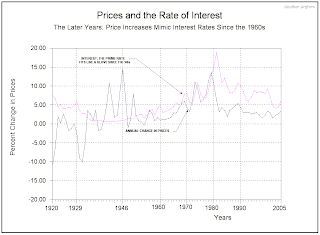Previously (25 April 2010: The Policies of the Venn Overlap) I noted a change in our economy from "money in circulation" to "credit in circulation." To my way of thinking, this change is the source of our economic troubles. So I was happy to see Jerry's comment that the post reminded him of two graphs I'd done for my "12 pages" PDF.
But in private correspondence Jerry had second thoughts about the value of those graphs. He writes:
Now I'm wondering, though, looking at the graphs again. The money supply graph I think makes a lot of sense. And shows that the correlation falls off later on. That supports your argument 100%.
Jerry's first remarks refer to my "Prices and the Money Supply" graph.
The graph shows inflationary peaks rising and falling under a canopy set by the quantity of M1 money relative to GDP, until 1960 or so. After that, as Jerry says, "the correlation falls off."
My point exactly.
So far, so good. Then Jerry drops the other shoe:
The other (interest rates) graph makes less sense to me. Something is certainly going on there, but it's not clear to me that what's going on is what you are saying is going on.
His comment here refers to my "Prices and the Rate of Interest" graph.
In this graph you can see that the sharp ups and downs of inflation in the 1920-1960 period show little similarity to the tame, flat trend of interest rates during that era. But after 1960 the two trend-lines show a lot of similarity: Just the opposite of the "Money and Prices" graph. The periods of similarity occur at different times.
The two graphs together show a transition. They show consequences of the change in our economy from a reliance on money before 1960, to a reliance on credit since that time. My graphs show that inflation used to be closely related to money issued by the Federal Reserve, and that this is true no longer.
Yeah, maybe the graph seems to suggest that the rate of inflation is tied to the rate of interest. But I'm not saying that. I'm saying only that the use of money-that-costs-interest is different and more costly than the use of money that doesn't.



No comments:
Post a Comment